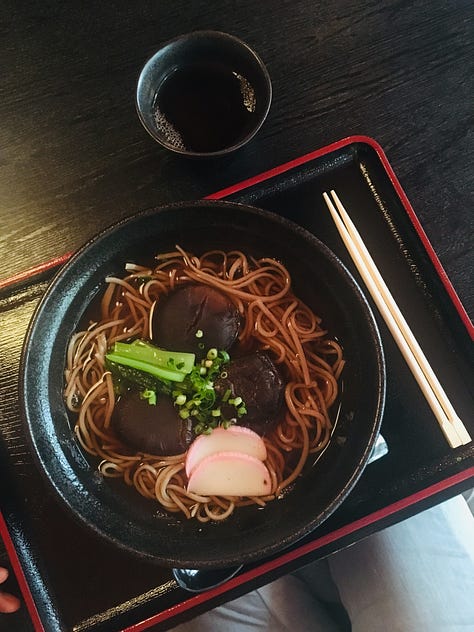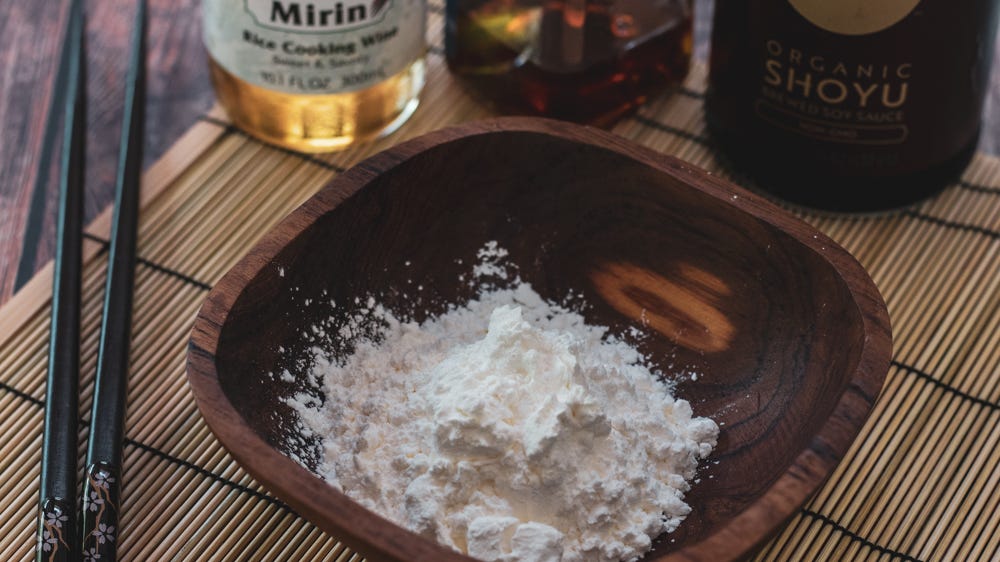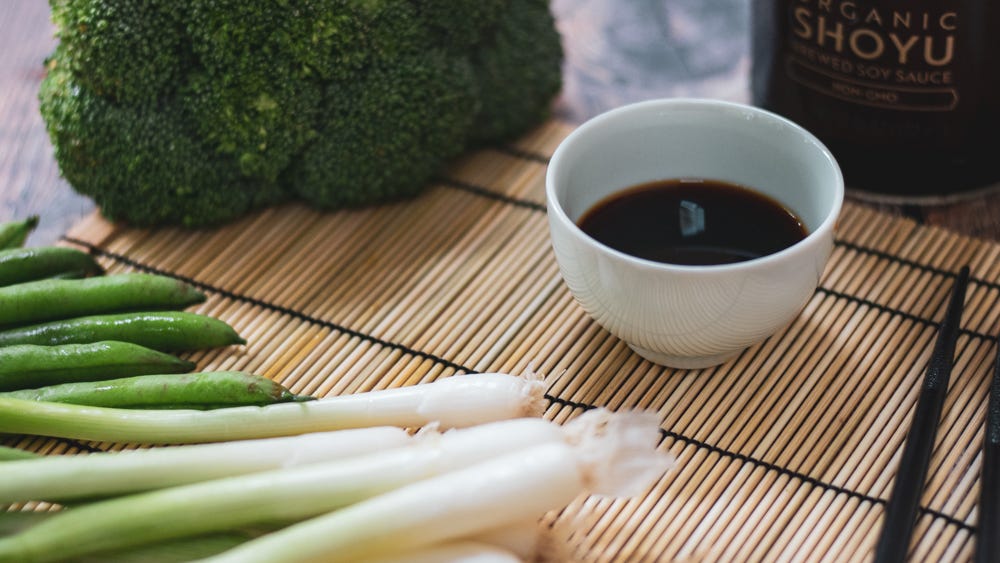Mel's Japanese Stir-fry with glazed Tofu
Plus Mel's Staples: Must-haves, essentials & more in your pantry & fridge Part 12
Dear fellow culinary enthusiasts, this is it. This will be the last edition of Mel’s Staples - Your no-excuse-recipe-guide. At least for now. Finishing this series doesn’t mean I won’t write any more blog posts and develop any more recipes in the future.
But for now I feel complete with twelve articles and 12 recipes using staples from your pantry & fridge. According to my gigantic list you should have a good amount of staples at home now that you can use for tons of recipes that exist out there, even those you were hesitant to make in the past. Even the Indian, the Oriental, the Central American and now also the Asian dishes.
This week’s blog post will feature one of my go-to Asian fusion kitchen recipes that leans more towards the Japanese cuisine.
A little bit of Story time…
My love for Japan, its rich culture and traditions, its beautiful nature and fascinating architecture, not to forget its broad range of delicious food, goes way back into my teenage years. At some point something inside of myself got ignited and I started collecting everything I could find about that amazing country: newspaper articles, photos.
I went to our local library and got travel guides about Japan, I read novels that took place in Japan. All of that was Pre-Internet, so no videos, no Google Searches, no Social Media. I even started practicing Karate at age 15.
And, I eventually started studying Japanese studies at Leipzig university and graduated. Since my first time in Japan almost 20 years ago, I have been back to Japan many times, some of them shorter visits, some of them longer, e.g. my internship at Goethe Institute Tokyo in 2004/05 and my internship at Obubu Tea Farm in Wazuka (near Kyoto) in the spring of 2019.
I’ve had many Japanese friends and language tutors aka tandem partners as we would call them, who introduced me into the Japanese cuisine, its umami flavors and interesting ingredients.



Every time I’ve been to Japan I indulged into the food. Since I went Veggie in 2015 it got a little more difficult, because the Japanese tend to eat lots of meat and fish. Not as much as the Koreans, but still. There is a Buddhist culture and certain religious traditions that involve even vegan food, and you can find restaurants for that in bigger cities.
But vegetarian food in general isn’t super easy to get in Japan, even though it often contains Tofu. Not as a main protein part to the meal, but as a side dish. Served in Miso Soups or as a side with a traditional Japanese meal that has many parts to it, veggies, rice, meat or fish, fish cake, salads, ferments or pickles and Tofu.
Speaking of which, the recipe I’ll be sharing with you below has Tofu, the firm type, so you can easily fry it.
Before we’ll dive into that, though, let me share some more of those staples with you.
Essentials for your pantry & fridge
Soy Sauce or tamari
Mirin
Toasted sesame oil
Corn or potato starch
Scallions or spring onions
All of this week’s staples are in the Essentials list. Simply because I don’t very often make Asian or Japanese cuisine inspired food. Similar to making Indian or Mexican or other country cuisine, I’d make it 2-3 times per month.
Especially in the summer and early fall months there’s just so much abundance of seasonal fruits and veggies, I would often just make a quick salad with everything that’s in season that time. Or a simple pasta dish using fresh sweet tomatoes, oven roasted potatoes or veggies. Or a Stir-fry. Perfect for all the Pak Choi, the string beans, the broccoli… you name it.
Soy Sauce (shoyu) or Tamari
I always have a bottle of soy sauce in my fridge. The umami flavor of this iconic sauce is just great with any dish really. Add it to a salad dressing to give it an umami punch or dip your (homemade) Sushi in it.
I looooove homemade Sushi - so I do eat fish from time to time! I was planning on making something else tonight, but I may just end up making Sushi - haha! Oh, by the way, you don’t need fresh fish for that, there’s plenty of Veggie options, egg, even Tofu that you can roll into your Sushi rolls.
Both Shoyu and Tamari are made from fermented soy beans and rice (using what is called Koji fermentation which involves rice), whereas Tamari seems to have a higher concentration of soy. It is a byproduct when making Miso paste, it’s literally the liquid that’s been squeezed out when miso is pressed.
For the recipe below I did use some Miso for the sauce, because I just had it in my fridge. Miso gives an even more umami flavor to your dish, it’s also quite salty, so you gotta be careful how much you end up using.
Mirin
While many people believe that soy sauce would already be the ultimate Japanese ingredient turning everything into a delicious dish, using Mirin - the Japanese cooking wine, you’ll reach a whole other level. Combine both and you’ll have THE flavor you’re looking for in a Japanese dish.
Of course, there’s other ingredients, too, such as rice vinegar, fish sauce, chili oil, even Sake. But for a start and to not stash you with a bunch of specific staples that you may not end up using again, Mirin and soy sauce will do.
Mirin is also made of fermented rice (using Koji fermentation) and sweet potato alcohol (shochu). It has a very distinct sweet and tangy flavor.
Toasted sesame oil
There’s two different sesame oils on the market, the one that’s made of raw sesame seeds and the other one that’s made of toasted sesame seeds. For the Asian cuisine you’d wanna use the toasted type.
It’s not only great for Japanese food, but also for Chinese, Taiwanese, Korean, etc. I use it a lot for Stir-fries and for frying the Tofu. Toasted sesame oil just tends to add to the overall Asian flavor for me.
Corn or potato starch
While you could also use regular all purpose flour, I tend to opt for corn or potato starch, when dusting/coating the Tofu for this recipe. The Asian cuisine uses starches a lot for coating their meat or Tofu, especially the Chinese kitchen does.
In doing that, your meat or Tofu gets a very crunchy and yummy crust that I personally love, when you fry them in toasted sesame oil!
Starches are also great thickener for sauces or stews, when you feel like they need a little thickening.
Scallions or spring onions
Using scallions or spring onions in stir-fries is totally optional. When I don’t have them at home, I just omit using them at all and simply use garlic.
If you do have them at home or wanna give this a try, add them more towards the end of the frying, because they tend to break down quite a bit. Or don’t add them at all while frying, but before serving.
Mel’s Japanese Stir-fry with glazed Tofu
This is a very easy recipe for which you do not need a Wok. A large skillet is sufficient for stir-frying your Veggies.
I’d often serve this Japanese stir-fry with rice, either basmati or sushi rice, but you can totally use long grain or brown rice.
For the Tofu, I usually opt for the glazing, that means I’d coat the Tofu with corn starch (using a small sieve) and then fry the pieces in toasted sesame oil. Then add soy sauce and mirin to that, which gives everything a nice and sticky glaze, which I absolutely love!
What you can also do, is frying your coated Tofu in toasted sesame oil and then make a sauce from soy sauce, mirin, more corn starch and water and dump your fried Tofu cubes in there. This is another delicious way of using the same ingredients, which tends to keep the crunchiness of the Tofu slightly better, I admit.
This is what you need for 2-3 servings
A bunch of seasonal vegetables (maybe about 1-1.5 lbs in total), I used string beans and broccoli. If you opt for Pak Choi use slightly more, because it tends to cook down quite a bit.
2-3 gloves of garlic, finely chopped
5-6 spring onions, chopped
1 block of firm Tofu
corn starch
soy sauce
mirin
salt & pepper
How to make Mel’s Japanese Stir-fry with glazed Tofu
Prepare the Tofu by getting them out of the container and using a paper towels getting out of the excess liquid as much as possible. You can also wrap the block in paper towels and put another plate on top to squeeze as much out as you can.
Meanwhile chop your vegetables to bite sized pieces and the garlic as well as the scallions, if using.
Cut your Tofu in chunks or bite sized pieces or even cubes. Lay them on a wooden board or a plate and dust them with corn starch from both sides. No need for salting them, because we’re gonna use soy sauce.
Prepare two skillets with adding toasted sesame oil to them.
I usually start frying the vegetables and the Tofu at the same time. If this seems too much multitasking for you, start with the Tofu, the vegetables will cook much faster.
Toast the Tofu from both sides until they turn golden brown, then add the soy sauce and the mirin (a good dash of both), turn them using a fork several times. Lower the heat and let reduce.
Add the garlic to the other skillet and let cook for a couple minutes. Then add your vegetables, starting with the ones that may need a little longer for them to get tender. In my case it was the string beans, I then added the broccoli and the scallions at the very end. Don’t overcook your veggies. Remember, it’s a stir-fry, that means fried on higher heat for just a couple minutes. You’d still want your veggies to keep that crunchiness and a bright green color, when using green vegetables as I did.
In a small bowl mix together 1/4 cup of soy sauce and about 1 tbsp mirin, some water and corn starch (about 1/2 tsp). This can be still liquid-y, it’ll thicken once it’s heating up. Add this to your skillet and let simmer for a couple minutes on low heat until you’ll get a nice sauce.
Serve your stir-fried vegetables with the Tofu on top and your favorite type of rice as a side dish. Enjoy!











